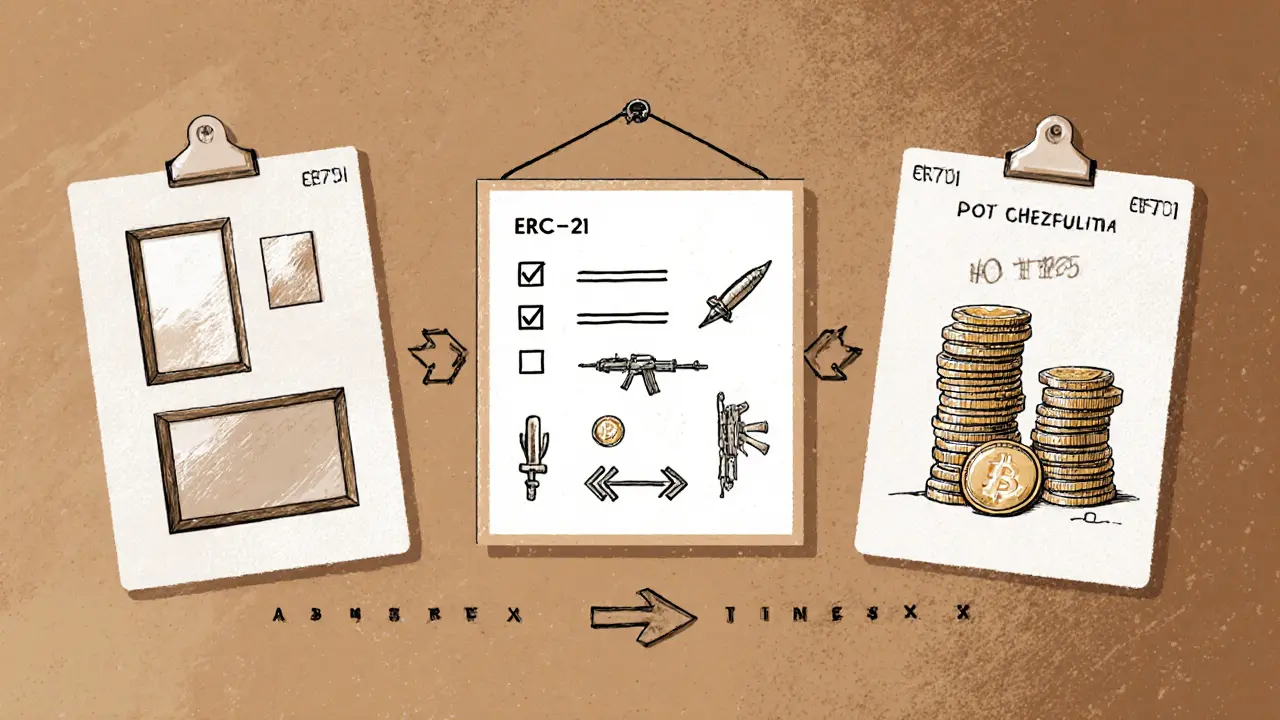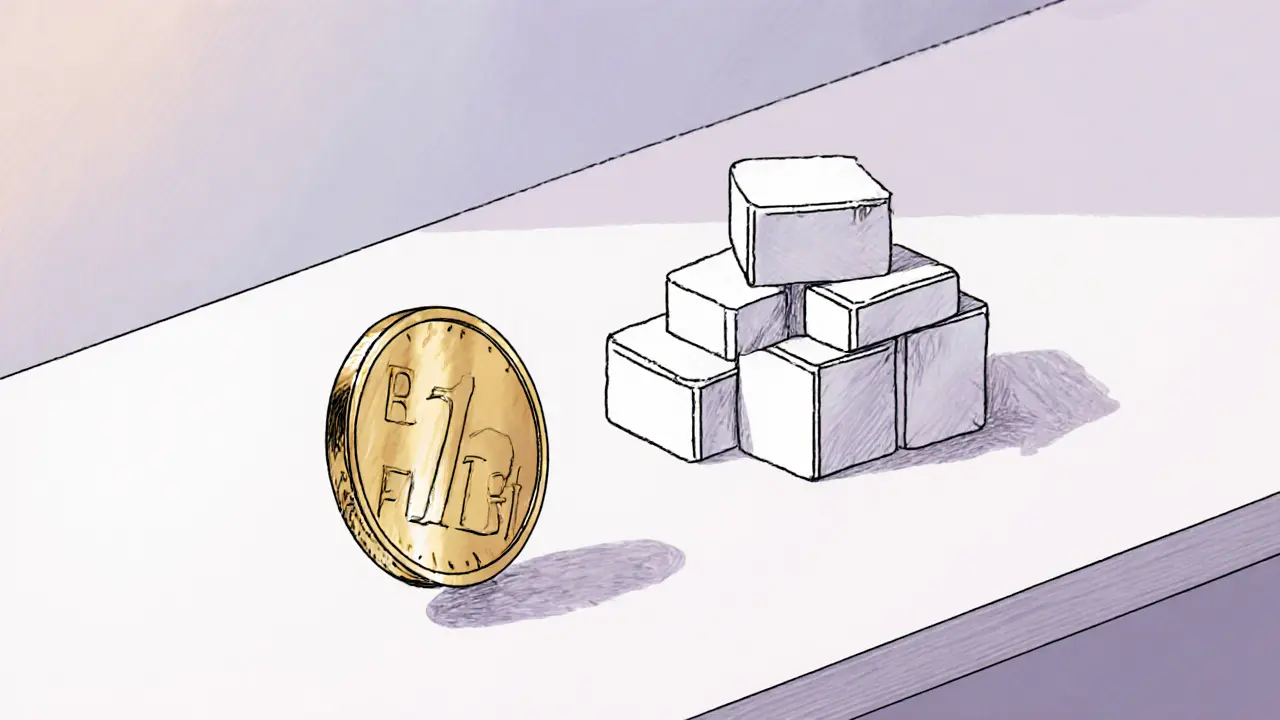NFT Gas Cost Calculator: ERC-721 vs ERC-1155
This calculator shows the estimated gas costs for transferring NFTs using ERC-721 versus ERC-1155 standards. Based on data from the article, ERC-1155 offers significant gas savings for batch transfers.
ERC-721 Cost
$0.00
ERC-1155 Cost
$0.00
Based on article data: ERC-721 transfers cost 50-70k gas per token, while ERC-1155 costs 5-10k gas per token. ERC-1155 offers up to 90% gas reduction for batch transfers.
Note: Actual gas costs may vary based on network conditions and specific implementation details.
When you start building NFTs, the first question is usually ERC-721 vs ERC-1155. Both standards live on Ethereum, but they solve different problems. This guide walks you through the technical differences, cost implications, real‑world use cases, and security quirks so you can pick the right tool for your project.
Key Takeaways
- ERC-721 is purpose‑built for single, unique NFTs; ERC-1155 lets you bundle fungible, semi‑fungible, and non‑fungible tokens in one contract.
- Batch transfers in ERC-1155 cut gas by up to 90% compared with ERC-721’s one‑by‑one moves.
- ERC-1155’s built‑in safety checks reduce the chance of losing tokens to wrong addresses.
- Use ERC-721 for pure art or collectibles; choose ERC-1155 for games, metaverse assets, or any project needing many token types.
- Implementation complexity is higher for ERC-1155, but the long‑term savings often outweigh the learning curve.
What the Standards Are
ERC-721 was introduced in January 2018 by William Entriken and teammates. It defines a single‑token type where each token ID points to its own metadata. Think of a digital painting where every piece has a unique serial number - that’s ERC‑721.
ERC-1155 arrived a few months later, created by Witek Radomski of Enjin. Instead of one token per contract, ERC‑1155 lets a single contract store many token IDs, each flagged as fungible, semi‑fungible, or non‑fungible. In practice, a game can keep gold coins, weapons, and skins all under the same contract.
Technical Architecture Differences
ERC‑721 requires a separate smart contract for each collection. The contract holds a mapping from token ID to a URI that points to off‑chain metadata (often stored on IPFS). Because every token lives in its own slot, the contract size grows quickly, and each transfer calls a distinct function.
ERC‑1155 uses a multi‑token mapping where a single contract stores an array of balances per token type. The uri function can return a template that substitutes the token ID, meaning you don’t need to store a unique URI for every token on chain. This design dramatically reduces storage needs and opens the door for batch operations.
Gas and Performance
Gas is the biggest cost driver for developers. A typical ERC‑721 transfer costs roughly 50,000‑70,000 gas, and minting a batch of 10 NFTs can cost as much as 600,000 gas. ERC‑1155 shaves that down to about 5,000‑10,000 gas per token when you use the safeBatchTransferFrom function. Chetu’s blockchain analysis reports up to a 90% reduction in gas when batch processing 100 tokens.
Because ERC‑1155 can move dozens of tokens in a single transaction, the network sees fewer pending transactions. Benchmarks from Merkle Science show ERC‑1155 handling 150‑200 token moves per second, while ERC‑721 struggles with sequential transfers that take 15‑30 seconds each.
Security and Error Handling
ERC‑1155 includes an optional onERC1155Received hook that verifies the recipient contract can handle the token type. If you send an NFT to the wrong address, the standard can automatically revert or even allow a recovery path. ERC‑721 lacks this built‑in safeguard, so a wrong address often means a lost token unless the sender manually intervenes.
Both standards support “burn” functions, but ERC‑1155 logs the full lifecycle (mint → transfer → burn) in a single event series, making audit trails easier for compliance‑focused projects.
Use‑Case Landscape
Artists, collectors, and marketplaces such as OpenSea still favor ERC‑721 for single‑piece art, PFP collections, and any scenario where uniqueness is the selling point. The standard’s simplicity and longstanding tooling (OpenZeppelin templates, Alchemy tutorials) make it a safe bet for newcomers.
Game developers, on the other hand, gravitate toward ERC‑1155. Platforms like Enjin and Immutable X leverage batch minting to create thousands of in‑game items-coins, weapons, armor-without exploding gas costs. The ability to mix fungible and non‑fungible assets under one contract speeds up updates and reduces deployment overhead.
Enterprises building loyalty programs or supply‑chain tokens also appreciate ERC‑1155’s flexibility. A single contract can represent a voucher (fungible), a unique certificate (non‑fungible), and a semi‑fungible batch of product IDs.

Implementation Complexity
For a developer fresh to NFTs, ERC‑721 is the lower‑hurdle. OpenZeppelin’s ERC721.sol library, dozens of blog posts, and a large GitHub ecosystem mean a junior dev can go from zero to a minted collection in 2‑3 weeks.
ERC‑1155’s multi‑token logic adds a learning curve. You need to understand balance arrays, batch functions, and the optional safety hooks. The average learning time reported on Stack Overflow is 4‑6 weeks. However, once mastered, the same contract can replace multiple ERC‑721 contracts, cutting long‑term maintenance.
Comparison Table
| Feature | ERC‑721 | ERC‑1155 |
|---|---|---|
| Token Types Supported | Non‑fungible only | Fungible, non‑fungible, semi‑fungible |
| Contract Deployment | One contract per collection | Multiple token types in one contract |
| Gas for Single Transfer | ≈ 50‑70 k gas | ≈ 5‑10 k gas |
| Batch Transfer Capability | No native batch support | Built‑in safeBatchTransferFrom |
| Storage Efficiency | Higher due to per‑token URI storage | Lower; shared URI template |
| Security Hooks | Basic onERC721Received |
Enhanced onERC1155Received with recovery options |
| Typical Use Cases | Art, collectibles, PFPs | Gaming, loyalty, mixed‑asset platforms |
| Learning Curve | Low (2‑3 weeks) | Medium‑High (4‑6 weeks) |
Future Outlook
Both standards will live side‑by‑side for years. ERC‑721A, an optimized fork released by Azuki in 2022, narrows the gas gap by allowing batch minting while staying ERC‑721 compatible. Meanwhile, the ERC‑1155 community is pushing cross‑chain wrappers and Layer 2 integrations that will make its already low gas fees even cheaper.
If you’re building a simple art gallery, ERC‑721 still makes sense-its ecosystem is massive, and marketplaces already expect that format. If you anticipate scaling to thousands of items, need both currencies and collectibles, or plan to integrate a DEX for batch trading, ERC‑1155 gives you the headroom to grow without swapping contracts later.
Decision Checklist
- Do you need only unique items? → ERC‑721.
- Will you handle multiple asset types (currency + items)? → ERC‑1155.
- Is gas budget a primary concern? → ERC‑1155 batch ops.
- Do you have a tight development timeline? → ERC‑721 (more tutorials).
- Are you targeting gaming or metaverse platforms? → ERC‑1155.
Next Steps & Troubleshooting
If you choose ERC‑721, start with OpenZeppelin’s ERC721.sol, follow Alchemy’s quick‑start guide, and test on a testnet like Sepolia.
If ERC‑1155 is your pick, clone the ERC1155.sol template, pay special attention to the uri(uint256) function and the batch‑transfer syntax. Common pitfalls include forgetting to approve the marketplace contract for batch moves and mixing token IDs that are flagged incorrectly as fungible.
Regardless of the standard, always double‑check your smart contract address before sending tokens. A simple callStatic check can save you from costly mistakes.

Can I use both ERC‑721 and ERC‑1155 in the same project?
Yes. Many projects deploy separate contracts: one for pure art (ERC‑721) and another for game items (ERC‑1155). The two standards are compatible with the same wallets and marketplaces.
Which standard is more widely supported by NFT marketplaces?
OpenSea, Rarible, and most secondary markets still prioritize ERC‑721 for art collections. However, newer platforms like Immutable X and Enjin’s marketplace have native ERC‑1155 support for batch trading.
Does ERC‑1155 require more gas for a single NFT mint?
A single non‑fungible token minted with ERC‑1155 can be slightly more expensive than ERC‑721 because the contract includes extra logic for handling multiple types. The cost gap closes when you mint or transfer many tokens at once.
Are there security concerns unique to ERC‑1155?
ERC‑1155’s batch functions can be a vector for replay attacks if you don’t implement proper nonce checks. Using the standard’s built‑in safety hooks and following best practices from OpenZeppelin mitigates these risks.
What’s the learning curve difference for developers?
ERC‑721 tutorials abound; a beginner can launch a simple collection in 2‑3 weeks. ERC‑1155 requires understanding multi‑balance mappings and batch calls, typically taking 4‑6 weeks to feel comfortable.

